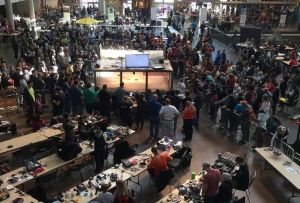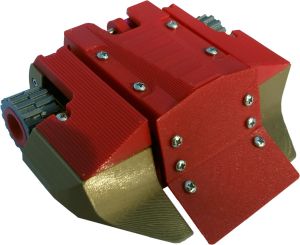Difference between revisions of "GettingStarted"
m (→Pick a weight class: Add photo along weight class & design) |
m (→Pick a basic design: Link to 3D printer page) |
||
| Line 28: | Line 28: | ||
==Pick a basic design== | ==Pick a basic design== | ||
| − | Building and competing with your robot is supposed to be fun. Know yourself and pick a design that you will enjoy but be sure to do something within your capabilities. Building a pneumatic flipper with no prior experience isn't a good choice for your first bot. Many in the hobby recommend starting with a simple pusher or lifter design, and some places have bot building classes or events. You might choose to build a '''[[Kits|kit]]''', or build your own using a 3D printer | + | Building and competing with your robot is supposed to be fun. Know yourself and pick a design that you will enjoy but be sure to do something within your capabilities. Building a pneumatic flipper with no prior experience isn't a good choice for your first bot. Many in the hobby recommend starting with a simple pusher or lifter design, and some places have bot building classes or events. You might choose to build a '''[[Kits|kit]]''', or build your own using a [[3D Printing|3D printer]]. |
==Pick components== | ==Pick components== | ||
Revision as of 09:27, 13 December 2021
There is so much to do!
There are a lot of guides to help new builders get started. Everyone's goals and skills are different, so no single guide will work for everyone. Some people love the design process while others enjoy the feeling of accomplishment when building something new. Take your time and gather the bits and pieces that work for you. There are a lot of different approaches to building your first robot.
Getting Started Guides
- The most comprehensive is the RioBots tutorial, packed with engineering know-how and real life experience. Beginners with small bots don't need to read this to succeed, but at least skim it to learn the basics and gain inspiration.
- Robert Cowan's Combat Robot Resource Guide is packed with useful links and tips.
- Peter Garnache's Combat Robotics Design Handbook is a great resource for bot builders looking to learn more about bot design, manufacturing techniques, or even just the classifications and naming conventions used in combat robotics.
- Build an Antweight is a great visual guide to the process.
- New Zealand guide to getting started connects "kiwis" with the local scene.
- The Box is Locked helps you prepare for your first competition.
- Reddit on getting started has more great links.
- SparkFun had a rundown article by Cowan with great photos.
How to get started in combat robotics
Go to events
Many new builders get hooked by watching robots on TV or on YouTube. There is a lot you can learn from watching matches, but there are so many decisions to be made around bot design, components, rules and a hundred other things that it can be difficult to know where to start. The first thing that every new builder should do is to go to Events and see how things are done in the real world. There are hundreds of great videos out there showing robot combat, but you'll learn a lot about things by attending an event. Even if you don't have a robot, you should ask the event organizer if it is OK to walk around the pits and talk to the builders. Watching them prepare for their matches and repair robot damage will help you figure out what you'll need for your first event. While builders are generally friendly and helpful, do remember to be courteous, as many of them will be preparing for a battle with very limited time, and often will not be able to talk to you while they work.
Learn the rules
Each robot combat event is governed by rules that specify such things as bot size and weight, allowable weapons, and safe behavior for both you and your bot. Learn what you are allowed to bring, how the event is scored, and how matches are structured. Listen in during the Driver's Meeting before the first match for a summary of requirements for participants.
When you compete, read the event rules carefully; even if an event adopts SPARC rules or another standard, local changes are not uncommon. Check with the event organizers if you have any doubts about whether your bot will be accepted.
Pick a weight class
Once you've been to an event and decided to built a robot, you need to pick a weight class for your first build. Most people in the hobby recommend starting with insect-weight bots (the smallest and lightest classes). Take into consideration which weight classes are supported in the event(s) you plan to attend, your budget, and your building skills. Generally things get more expensive as they get bigger and the building / fabrication requirements are very different for a 1-pound robot vs. a 30-pound robot. Start with something that you think you'll be able to complete and if you have fun then build a second and third robot.
Pick a basic design
Building and competing with your robot is supposed to be fun. Know yourself and pick a design that you will enjoy but be sure to do something within your capabilities. Building a pneumatic flipper with no prior experience isn't a good choice for your first bot. Many in the hobby recommend starting with a simple pusher or lifter design, and some places have bot building classes or events. You might choose to build a kit, or build your own using a 3D printer.
Pick components
Some people spend a ton of time picking motors and batteries and all the things that go into your first robot. It pays to take some time and make informed choices, but even advanced builders iterate and discover new components to improve their bots. Don't let 'perfect be the enemy of good'. Pick things that work, then iterate and make improvements over time as you go. If you are new to fabricating things take a look at the NameThatPart page to learn about different materials and some of the basic things you'll need to create your robot.
Build and test your robot
Before you start your build you want to make sure you have the right tools. Nothing is more frustrating than setting aside time to build your robot only to find that you are missing an important tool. As you put your robot together you should be testing it but safety is always important. Do a wheels-up test of your drive system to make sure the drive system is working as expected. If your bot has a weapon you want to make sure that the failsafe is working correctly. Test the failsafe with just the motor first. Once it is working correctly you can test with the weapon attached. Weapons tests should be performed using a reinforced test box. Some builders will set up a camera to observe and record the bot while they and others remain safely out of the way.
Prepare yourself
Two keys to success in the bot arena are driving and strategy. First, you must become a master of your own bot. Find or make a safe place to test your bot without chance of injury to yourself, family, pets, and others, and get plenty of practice driving it as often as possible. Learn how long the battery will hold out before it must be charged. If possible, adjust your controls so that the bot moves and performs as your hands expect it to. Practice your moves, just as with any sport, even if all you have is a wood-block dummy to push around.
You will need to effectively engage your rivals in the battle arena, identifying their strengths and seeking out and exploiting weaknesses in their bot designs and in their own driving. Only in real combat will you learn all the instincts needed to adapt to ever-changing situations. Robot combat is a true sport, and its techniques can be learned and studied not only by watching the videos, but by going to events and fighting.
Finally, steel yourself for failure. Parts will fail, things will break, batteries run out, circuits overheat, gears jam, connectors come unplugged, and mighty opponents may cut your bot to ribbons. "The general rule of thumb in any robot competition regardless of weight class is not to put a bot in the arena you aren't comfortable having destroyed."[1] If defeat comes, congratulate your opponent, return to the pits, rebuild, and return to the arena and triumph.

